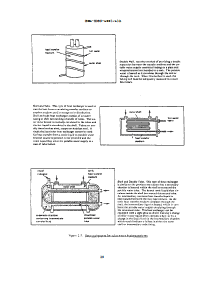Design criteria
This handbook presents design criteria and cost analysis methods for the sizing and justification of solar heat collectors for potable water and space heaters. Sufficient information is presented to enable engineers to design solar space conditioning and water heating systems or conduct feasibility studies based on solar collector performance, site location, and economics.
Both retrofit and new installations are considered.
Solar radiation
Energy from the sun is received by the earth as electromagnetic radiation. Most of the energy is received in the visible and infrared portions and a small amount as ultraviolet radiation. North of the Tropic of Cancer (23 deg. N latitude), the sun makes a daily arc across the southern sky from east to west as shown in Figure 1-1. For a typical location at 32 deg. N latitude the sun would be 81.5 deg. above the southern horizon or nearly overhead at noon (solar time) on June 21 while on December 21 it would be only 34.6 deg. above the horizon (Barnaby et al., 1977).
Solar insolation (I) is measured in Langleys (L) or Btu/ft‘2‘. One Langley equals 3.688 Btu/ft‘2‘. The amount of solar energy that exists outside the atmosphere, often called the solar constant, is 116.4 L/hr or 429.2 Btu/ft‘2‘-hr. At most 70% to 80% of this amount will strike the earth’s surface, the remainder being absorbed or reflected in the atmosphere.
Monthly average and yearly average daily insolation data for numerous locations are given in Table 1-1. In general, the higher the latitude, the less insolation is received on a horizontal surface.
Collecting solar energy
Collection of solar energy is based on the very high absorption of radiant energy by dull, black surfaces and on the “greenhouse effect.” The latter refers to the ability of glass to transmit visible radiation but prevent the loss of heat from the collector plate which radiates at longer wavelengths (infrared frequencies). Glass (or plastic) cover plates are generally used over flat absorber plates to reduce heat loss (see Figure 1-2). The heated absorber plate may have a fluid (water, air or other) pass over it or through tubes attached to the plate.
The fluid thus heated may be used to heat potable water, heat spaces, or drive an absorption or Rankine power cycle air conditioner.
| Title: | Solar Heating of Buildings and Domestic Hot Water |
| Format: | |
| Size: | 1.3MB |
| Pages: | 162 |
| Download: | Right here | Video Courses | Membership | Download Updates |



The articles published by EEP is thoroughly knowledgeable and helpful.